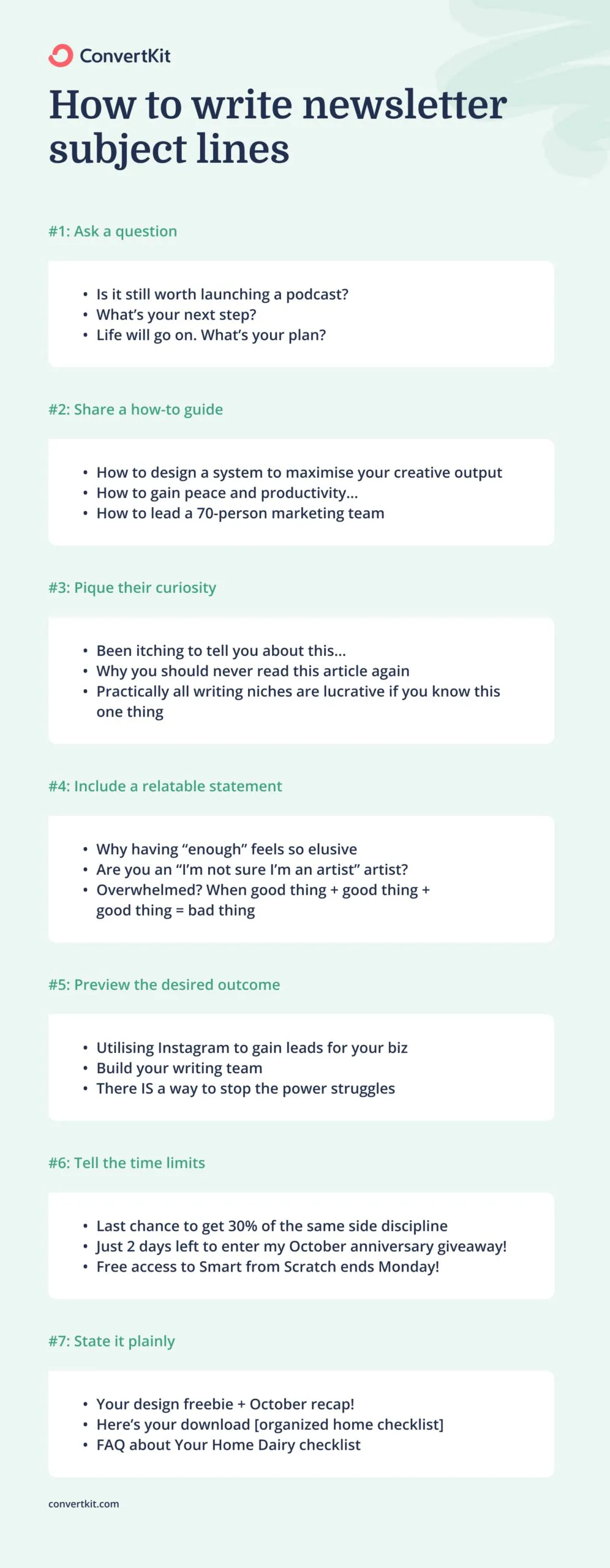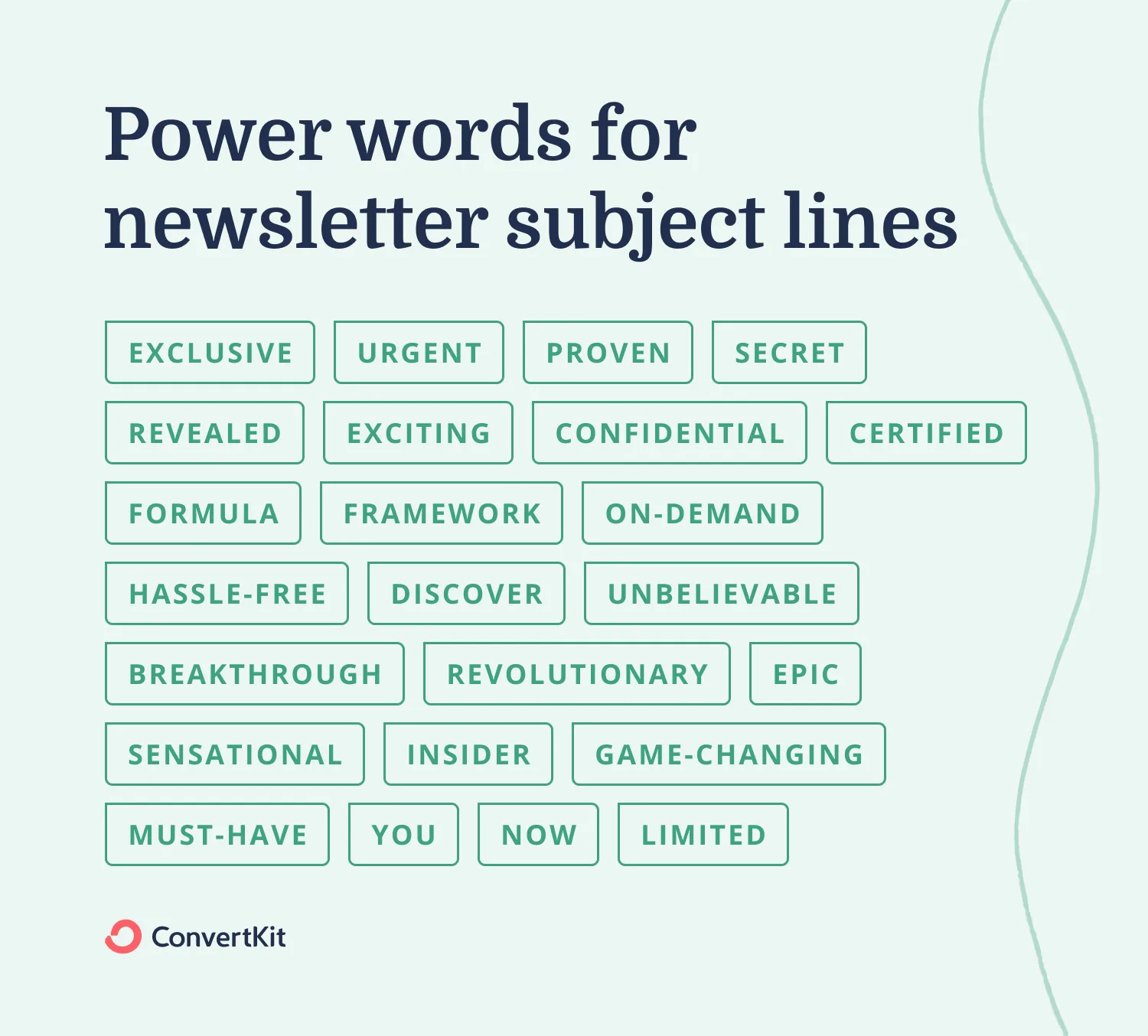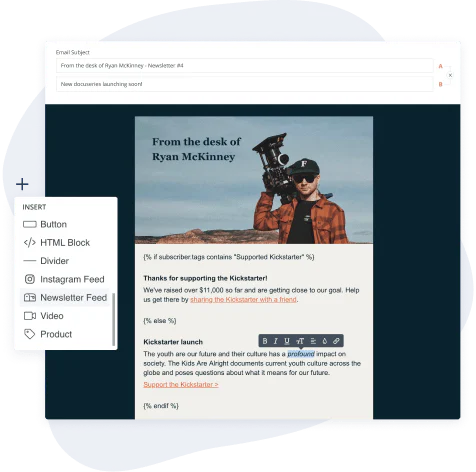In this Article
You’ve spent months building your email list and hours designing your newsletter every week.
But your open rate remains minimal.
It’s not your fault. Work emails, transactional emails, and other sign-up emails flood inboxes, and suddenly you’ve got an overcrowded space where each email is fighting to get opened.
The solution: focus on your newsletter subject lines.
What is a newsletter email subject line, and why should it be a top priority?
A newsletter subject line is text that tells you the content of an email and helps you decide whether or not you should open it. Subject lines are one of the most important aspects of your newsletter because it’s the first thing recipients see in their inbox.

Your newsletter subject line is also important for a number of different reasons:
- Increases open rates: An attention-grabbing subject line is one of the most sure-shot ways of getting a high open rate, which can vastly contribute to the success of your newsletter and retain your audience.
- Ensures good email deliverability: The last thing you want is for your newsletter to end up in the dreaded spam folder, which can be triggered if you include spammy words or clickbait in your subject lines. This calls for more conscious effort in crafting subject lines.
- Sets the tone: Your subject line gives the reader a glimpse into what they can expect from your newsletter, giving them a reason to open the email. A well-crafted newsletter subject line increases the chances of your recipients opening and engaging with the email.
Strategically thinking about your subject line from the reader’s point of view after you write your newsletter can significantly help you boost your metrics and retain subscribers in the long term.
10 styles of subject lines for newsletters the pros use (plus 40 real-life examples)
Before you pull your hair out wondering what kind of subject line encourages your audience to open your email, let’s look at some subject lines that creators have used and got excellent results with.

Style #1 – Ask a question
One of the most common ways of writing a newsletter subject line is to ask your recipient a question. This format is short, crisp, grabs attention quickly, and makes people curious about the answer, encouraging them to open the email and see if they were right.
Examples by creators
- Is THIS hurting your chances at publication? – Eva Langston
- You don’t want FOMO, do you? – AppSumo (open rate = 60%)
- Is it still worth launching a podcast? – Ryan Robinson
- Am I the only one with a bunch of questions? – Brian Dean
- Is your Game Day menu ready? – Butcherbox
- Generalist or Specialist? – Kjell Vandevyvere

Kjell’s subject line asking a simple question around what is better – to be a generalist or specialist got a 53.9% open rate. Image via Kjell Vandevyvere.
Style #2 – Sharing a how-to guide in your newsletter subject line
To give your subscribers a straightforward reason to open your email, give your subject line a how-to title and talk about the end outcome you help the reader achieve with your newsletter. This is best if you’re answering a frequently asked question or solving a common problem your readers face.
Examples by creators
- How to grow your business faster in 15 minutes – Salesforce
- How to find and connect with journalism recruiters – Mandy Hofmockel
- Here’s how to land your first freelance client – Kat Boogaard
- How to survive your next overnight flight – Thrillist
- How to lead a 70-person marketing team – Jimmy at Superpath

Superpath’s descriptive subject line about managing large teams had a 56.7% open rate. Image via Superpath.
Style #3 – Piquing their curiosity
Curiosity is one of the best ways to push your audience to open an email. Include a shocking stat or write a controversial statement while ensuring it’s not misleading and make it seem like you’re giving away a secret.
Examples by creators
- I was right – and that’s not good for you – AppSumo (open rate = 69%)
- *Don’t Open This Email* – Manicube
- Almost no one thinks this way.. – Devin Reed
- Instead of Sharing Expertise, Try Sharing This… – John Bonini from Some Good Content

Everybody loves a cliffhanger, and John Bonini doesn’t disappoint with this subject line that’s bound to make you curious. Image via Some Good Content.
Style #4 – Including a relatable statement
Newsletters build a relationship with your audience and empathize with their challenges. If you’re sharing personal stories or your take on unpopular opinions, add a relatability factor to your subject line to show they’re not alone.
Examples by creators
- Kale chips are not as good as potato chips. – Randi at Bohemian Vegan Kitchen
- I could be spending my time better – Ali Abdaal
- I don’t know what’s next – Kat Boogaard
- I Still Can’t Find My Freelance Writing Client!!!! Ahh! – Elna Cain

Elna Cain targets a relatable emotion every early freelancer faces – not getting their first client with this subject line that has an open rate of 38.2%. Image via Elna Cain.
Style #5 – Previewing the desired outcome
If you’re writing a newsletter covering a step-by-step guide, pique your reader’s curiosity and craft a subject line telling them what they can achieve and how—it’s like promising a pot of gold at the end of the rainbow.
Examples by creators
- Everything you wanted to know about email copy but were too afraid to ask – Copyhackers
- 6 Ways Freelancers Can Win Dream Gigs, Defeat Inbox Ghosts, and Level Up – Jon Morrow
- There IS a way to stop the power struggles – Nina Garcia
- Get 1,410 replies on your next tweet – Katelyn Bourgoin

If readers can preview what they can learn from an email through the subject line itself, it can be a major pull to open the email, and Katelyn does this well. Image via Katelyn Bourgoin.
Style #6 – Telling the time limits (aka F.O.M.O.)
A sense of urgency is great because it gets people to act under pressure quickly, especially if you’re announcing discounts, promotions, sales, or offering any coupons. However, don’t use it too frequently to avoid triggering spam filters, impacting your email deliverability.
Examples by creators
- 📣 Ending soon: 50% off until midnight – Grammarly
- Uh-oh, your prescription is expiring – Warby Parker
- Just 2 days left to enter my October Anniversary Giveaway! – Angela Fehr
- One more day to grab Premium with 50% off 🤫- Copyfolio

Copyfolio’s subject line instills FOMO by highlighting the time left before their 50% discount offer expires in a simple yet effective way. Image via Copyfolio.
Style #7 – Stating it plainly
Keeping it simple is one of the most underrated yet effective ways of grabbing your reader’s attention, whether welcoming them to your newsletter or sending one of your regulars. It’s a great way to keep things straightforward and get the message across immediately to convey that you respect their time.
Examples by creators
- Freelance Writing Jobs: NME, Barbican, Art Review – Sian Meades-Williams (Sourced from my personal inbox, here’s a screenshot)
- Your Design Freebie + October Recap! – Teela from Every Tuesday
- 100 Life Tips, Self Handicapping & More – Sahil Bloom’s Curiosity Chronicle

Sahil Bloom’s subject lines keep it simple by stating what the readers can find inside the email, giving them a clear reason to open. Image via the Curiosity Chronicle.
Style #8 – Personalizing the subject lines for newsletters
Are you more likely to open an email that directly addresses you like it’s meant for you only or a generic one?
Probably, the former. And the numbers don’t lie.
Personalized subject lines can get an open rate of up to 39% compared to 10% for those that don’t. This works because personalization makes people curious, establishes a direct personal connection, and builds a sense of sincerity, significantly boosting your open rate.
Examples by creators
- I’m Saving You a Seat Next to Me on the Beach… – Matthew Hussey
- (first name), become a pro at LinkedIn Marketing – LinkedIn ads
- RE: This company wants to hire YOU (seriously) – Jon Morrow from SmartBlogger

The power of the word “you” is supreme in establishing a direct contact with the reader, and Jon Morrow does this well in this subject line. Image via Smart Blogger.
Style #9 – Adding a sense of humor
If you want a unique newsletter subject line, make it funny by introducing humor. Crack a joke, include a pun, or leverage a trend to make it relatable yet amusing. Consider adding an emoji to give your wit an extra kick.
Examples by creators
- Honest Tea is the best policy – Retail Brew
- What do ghosts have for breakfast? 👻 – Greetabl
- Best of Groupon: The Deals That Make Us Proud (Unlike Our Nephew, Steve) – Groupon
- I Cannes see clearly now – Marketing Brew

Marketing Brew’s subject line combines a timely trend with humor to create a pun that can stand out in an inbox full of generic subject lines. Image via Marketing Brew.
Style #10 – Seasonal newsletter subject lines
Whether it’s the fall season, Black Friday sale, Thanksgiving, or Valentine’s Day, holidays call for creative subject lines that can quickly turn heads.
If you’re promoting seasonal products and discounts, make your subject line more timely and unique by tapping into a relatable feeling attached to the occasion to encourage readers to open your email.
Examples by creators
- Exciting Mystery & Thriller Reading for Summer – Goodreads
- In The Summertime – The Jurni
- It’s like summer in a cup – Country Bean

Country Bean’s subject line promotes their seasonal coffee flavors by highlighting a feeling associated with them. Image via the Country Bean.
What you need to keep in mind to write a great newsletter subject line
The styles we’ve discussed above are great starting points. But when you sit down to write a subject line for your newsletter, there are a few things you need to consider.
- Who will receive your email: If your newsletter is going to freelancers vs. CEOs, there will be a huge difference in how you address them and which problem statements they’re most likely to relate with. So, think about their most prominent challenges and lead with them.
- What action do you want them to take?: Do you want readers to respond to your newsletter, sign up for a course or read a new blog post? This will define how you start your email from the subject line to set the tone.
- What tone of voice suits your newsletter best?: Managing reader expectations isn’t a cakewalk. But achieving consistency in how you talk to them can make a lot of difference. It’s usually best not to be straightforward in one subject line and super funny in the other because it might confuse your readers. Prioritize consistency with a few diversions occasionally to spice things up.
Thinking about these subject line elements before hitting send on your email can help you find the best style for your newsletter. And then it’s all about consistency.
Best practices specific to newsletter email subject lines
You don’t have to hit the ball out of the park each time you write a subject line, but following a few best practices can help you get the most out of your newsletter efforts:
- Keep it crisp: The longer your subject line, the more time it takes to read, reducing the chances of grabbing your readers’ attention.
- Personalize your emails: Personalization doesn’t end at including your reader’s name in the subject line. Address their profession, location, interests, and preferences to help form stronger audience connections.
- Leverage pre-header text: This is your subject line’s subtitle and can give your reader a better glimpse into what you’re discussing in the email. This is a great way to keep the subject line shorter while tapping into this precious real estate to drive your audience to open the email.

Pre-header text can be a good segue between your subject line and the email, providing the reader with enough context to make them intrigued, as in Tommy’s example. Image via the Content Studio.
- Optimize for mobile: People constantly open emails on their phone. If they’re met with a poor experience, they might bounce—no matter how good the content of your email is. This means using clean fonts, keeping the subject line below 40 characters so they don’t get cut off, and front-loading your subject line so the context is established within the first few words.
- Use power words: Some words generate a greater impact than others and can intrigue your audience to open the email. They touch upon specific emotions to trigger the reader to read your newsletter. Here are a few to get you started.

How to improve your newsletter subject lines over time
Writing highly engaging newsletter subject lines is an art. You need to master it over time instead of trying to write the perfect one every time. Here’s how:
Check your subject lines before you hit send
It can be a rush to send the newsletter you spent so much time writing but hold it back for two more minutes and go through it again before you send it to your audience.
Test your newsletter subject line for the length and content, and ensure it’s optimized for mobile and touches on your audience’s biggest challenges and roadblocks.
Learn from past performance
Analyzing your past performance is one of the best ways to improve your subject-line writing skills.
Identifying recurring trends between your highest and lowest-performing subject lines is a good practice. For example, are subject lines with emojis performing better than those without them, or are how-to phrases getting a higher open rate than those without?
As you send more newsletters and try new subject lines, you’ll have more data to compare what a “good” open rate is for your list. An open rate of 20-30% is a good benchmark.
Run an A/B test
What worked for one newsletter edition may not work for another.
To establish a framework and identify what subject lines work best for you, test two emails with different subject line styles to establish your winner. You can also do it with different email combinations to precision your subject lines even further.
You can A/B test your newsletter subject lines easily with Kit’s free account.
You just need to add two subject lines, and Kit will send your newsletter with the different subject lines to a sample of your subscribers and give you the comparative results with the open rate and click-through rate.
The rest of your subscribers will then receive the email with the winning subject line.

Subject your newsletter to higher open rates!
Your subject line is your audience’s first impression of your newsletter, so you better nail it to the T. But don’t sweat it if they don’t perform well initially; practice, use the different subject line styles we’ve shared before, and compare your performance to make improvements.
If you’re ready to begin, create your free Kit account today.





